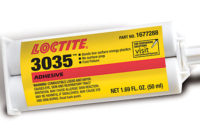The hardest part about assembling optoelectronic packages-or at least the most publicized-is the process of aligning the various optical components to maximize light transmission and locking them in place. But, the challenges don't stop there.
Just as tricky is the process of electrically connecting the optoelectronic chip to the circuit board and package leads. For one, the bonding surfaces are often made of different metals and located at significantly different heights. To protect sensitive components, wire bonding must be done at a lower force and temperature than other microelectronic applications. To make matters worse, the typical butterfly package doesn't offer much room for bonding tools to work. Finally, the high cost of optoelectronic packages and low production runs allow little room for experimentation to optimize the process.
To get an idea of the challenges involved in wire bonding these packages, consider a typical optoelectronic transmitter. It's housed in a 14-pin butterfly package, which is made of gold-plated Kovar and hermetically sealed. The package is approximately 1 inch long, 0.5 inch wide and 0.3 inch deep, with an optical fiber emerging from one end.
The light source is an edge-emitting semiconductor laser or a vertical-cavity surface-emitting laser. The laser is mounted to its own circuit board, or submount, which is made of a low-temperature cofired ceramic (LTCC) approximately 0.25 inch square. The laser is soldered to the submount with a "hard" tin-gold solder, which has a melting temperature considerably higher than the 150 C required for wire bonding.
The submount, in turn, is soldered to the main circuit board, which is also made of LTCC and which contains temperature sensing and control devices; an optical output sensor; a signal processor; an external modulator; and an attenuator.
All totaled, the transmitter might have 24 wires to be bonded, says Bradley K. Benton, product marketing manager with Palomar Technologies Inc. (Vista, CA). The output sensor, or back facet monitor, is glued to the submount behind the laser, and four to eight wire bonds connect it electrically to the laser and submount. A few more wires connect the laser to the submount. Feedback circuitry and frequency modulation components will add to the wire count.
The temperature control component, a Peltier device, is usually soldered into the package by hand. "If demand for optoelectronic components ever gets back to what it was in 2000, we will probably use wire bonding to connect that component, too," says Benton.
Bonding Challenges
The wire used in optoelectronic packages is usually round, gold wire 1 mil in diameter. Each of the two wire bonding technologies-ball bonding and wedge bonding-has particular advantages for assembling optoelectronic packages. Ball bonding is faster, and wires can be connected in any direction from the ball. Wedge bonding can be done at finer pitches and lower temperatures than ball bonding, and it's less sensitive to surface contamination. In addition, loops can be made at a lower profile.
"Any time we have the opportunity to ball bond, we will, because ball bonding is three to four times faster than wedge bonding," says Benton. "In addition, it's a well-understood and well-characterized process that can be used for high-reliability products."
Fortunately, most wire bonding with optoelectronic components is done on the submount, so the bonder has few obstacles to overcome. The tricky part comes once the submount is joined to the primary circuit board and mounted in the package. Some wires have to be bonded from the submount to the main circuit board and the package pins.
Standard ball bonding capillaries can't get close enough to package walls to bond wires to the leads. Special bottleneck capillaries are available for accessing tight spots, but they are more fragile than standard tools.
"There are limits to how much you can shrink that capillary," Benton points out. "But, a wedge tool can get really close to the edge of a wall, so in some cases, you may need to mix bonding technologies. You may have to use a wedge tool to bond to the leads, and a ball bonding tool to do everything else."
Vibration in the leads is another issue. Acting like diving boards, the leads can vibrate during bonding, diminishing the ultrasonic energy applied by the tool. If the natural vibration frequency of the lead is greater than half the ultrasonic bonding frequency, the lead will resonate, and bonding won't occur. Making the leads shorter and stiffer can solve the problem.
Optoelectronic packages are also deep. The height differential between the lowest and highest bonding sites can be more than 3 millimeters. Not only does this present a challenge to the bonder's vision system, but it also makes the tool more difficult to control. "An ultrasonic tool behaves more like a wet noodle than a rigid piece of ceramic," explains Benton. "The longer you make the tool, the more it whips around at the tip. So, you want to use as short a tool as possible."
At an ultrasonic frequency of 60 kilohertz, a standard length bonding tool for optoelectronic applications is 437 mils long. The next longest tool is 625 mils. "With a 625-mil capillary, you can get down into just about every optical package," says Benton. "If you had to go longer, there are wedge tools that are 750 mils and 1.078 inches long."
One of the toughest challenges to wire bonders for optoelectronic packages is bonding at low temperatures. A single optoelectronic package is often assembled with several different solder alloys, each with its own melting temperature. After the first component has been soldered in place, the next component is soldered with an alloy that melts at lower temperature. This prevents reflow of the first assembly and keeps carefully aligned components in place.
Wire bonding is performed after all the components have been soldered. The challenge is that the bonding temperature cannot exceed the lowest reflow temperature used in the assembly. In some cases, that temperature can be as low as 130 C.
Wire bonding can be done at 100 C. However, to compensate for the low temperature, the ultrasonic frequency must be increased. The pads may also need to be plasma-cleaned before bonding.
To control inductance and impedance in optoelectronic devices, the profiles of the wire loop must be consistent, straight and low. To improve yield, it may be necessary to make the first bond on the lower surface and the second bond on the upper surface-the opposite wire bonding pattern for most integrated circuit applications.
Ribbon Wire
Although ribbon bonding has not been used much for optoelectronic packages, it's beginning to get more attention, particularly for lasers that will be switching at very high frequencies. Ribbon bonding is a form of wedge bonding in which flat ribbon is used instead of round wire. Besides optoelectronic packages, ribbon wire is used in high-frequency military applications and medical devices, such as pacemakers and defibrillators.
"Ribbon wire allows you to get power to the diode better, cleaner and with less inductance than round wire can," says Benton.
Compared with round wire, ribbon wire has many advantages for first-level interconnections. Ribbon wire produces stronger bonds than round wire, because there's more contact between the wire and the pad. Because there's less bond deformation with ribbon wire than for round wire, heel cracking is less of an issue. The rectangular shape of the ribbon makes it easier to produce low loop profiles that put less stress on the first bond. The shape also allows longer spans to be made with less sag. Cratering is less of a problem with ribbon wire because the bond force and ultrasonic energy are distributed over a larger area. For optoelectronic applications, the key advantage of ribbon bonding is that it requires less force and energy than bonding methods for round wire.
Ribbon wire is not as good as round wire for applications that require the wire loops to fan out at angles from the chip. Similarly, ribbon does not perform as well as round wire in running chain, or stitch bonding, applications, if the chain goes off on an angle.
Most ribbon wire is gold, because of its superior bonding properties. But, it can also be made from aluminum, silver, palladium and copper. Ribbon wire is 6 to 50 microns thick and 50 to 500 microns wide. For best results, engineers should choose a ribbon wire with the highest possible ratio of width to thickness. And, as with round wire, fresh ribbon performs better than old ribbon.
Wedge-bonding tools for ribbon wire are similar to those used for round wire, except that the wire feed slot is rectangular. Key tool parameters include wedge length, shank style, surface smoothness, dimensional tolerances, and the size and style of the wedge foot. Key bonding parameters are force, time, the magnitude of ultrasonic energy, and the temperature of the bonding surface. For large wires, power and force are more important than time for producing a good bond. For small wires, time is more important. Good bonds can be produced at temperatures under 150 C, but the process window will shrink as temperature decreases.
It's normal for a round wire to be compressed by 20 percent during bonding. In contrast, the amount of ribbon wire that is squashed is much less. Good bonds can be achieved by compressing the wire by less than 10 percent, depending on the size of the ribbon. Because the ribbon is flat, the bonding process begins with the maximum amount of contact between the wire and the device.
Besides its superior bonding characteristics, ribbon wire also has excellent electrical attributes. High-frequency signals travel near the surface of a wire. This is called the skin effect. Due to the skin effect, a ribbon wire can carry much higher current than a round wire with the same cross-sectional area. Ribbon wire also has a lower inductance than round wire, and is less susceptible to cross talk.


